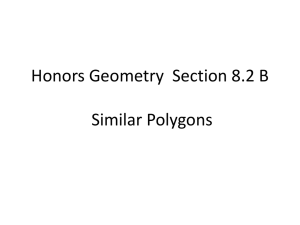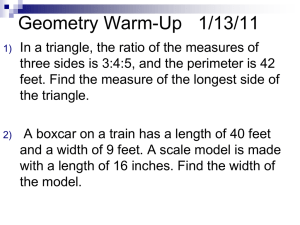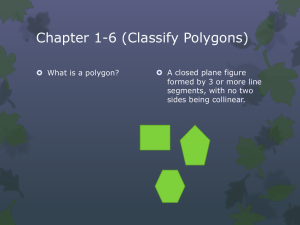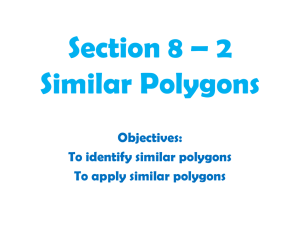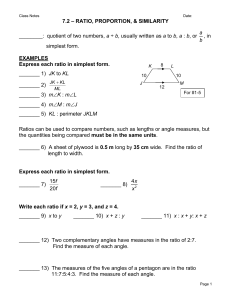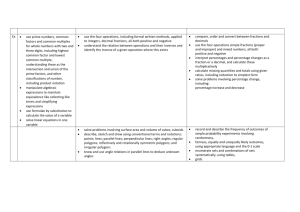File
advertisement
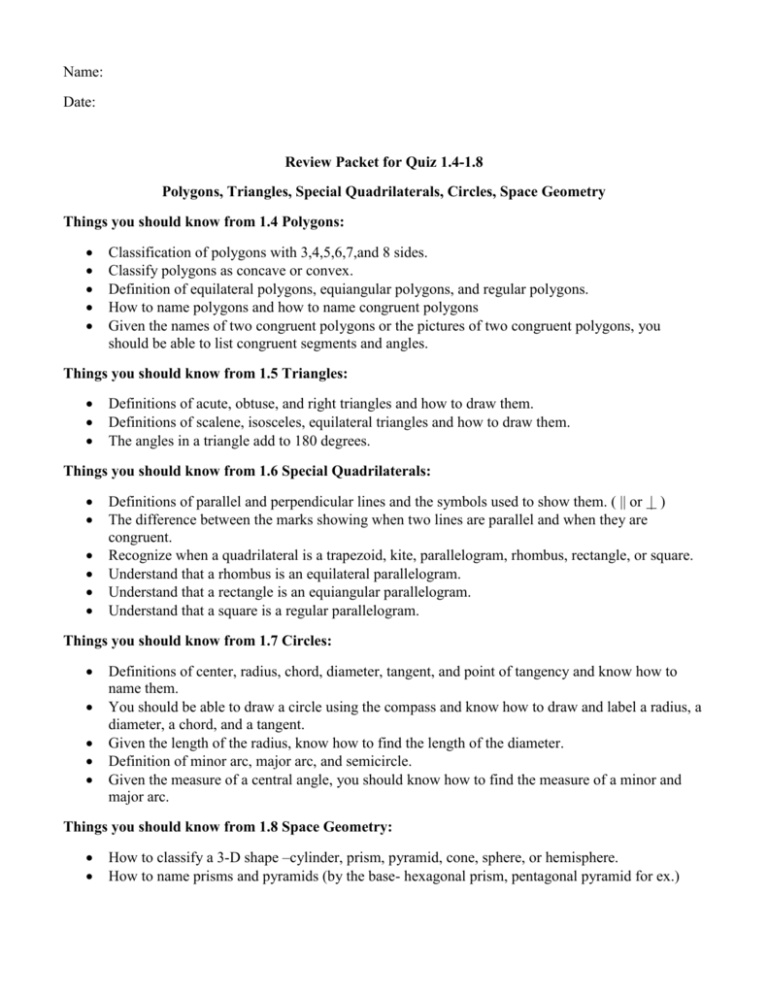
Name: Date: Review Packet for Quiz 1.4-1.8 Polygons, Triangles, Special Quadrilaterals, Circles, Space Geometry Things you should know from 1.4 Polygons: Classification of polygons with 3,4,5,6,7,and 8 sides. Classify polygons as concave or convex. Definition of equilateral polygons, equiangular polygons, and regular polygons. How to name polygons and how to name congruent polygons Given the names of two congruent polygons or the pictures of two congruent polygons, you should be able to list congruent segments and angles. Things you should know from 1.5 Triangles: Definitions of acute, obtuse, and right triangles and how to draw them. Definitions of scalene, isosceles, equilateral triangles and how to draw them. The angles in a triangle add to 180 degrees. Things you should know from 1.6 Special Quadrilaterals: Definitions of parallel and perpendicular lines and the symbols used to show them. ( || or | ) The difference between the marks showing when two lines are parallel and when they are congruent. Recognize when a quadrilateral is a trapezoid, kite, parallelogram, rhombus, rectangle, or square. Understand that a rhombus is an equilateral parallelogram. Understand that a rectangle is an equiangular parallelogram. Understand that a square is a regular parallelogram. Things you should know from 1.7 Circles: Definitions of center, radius, chord, diameter, tangent, and point of tangency and know how to name them. You should be able to draw a circle using the compass and know how to draw and label a radius, a diameter, a chord, and a tangent. Given the length of the radius, know how to find the length of the diameter. Definition of minor arc, major arc, and semicircle. Given the measure of a central angle, you should know how to find the measure of a minor and major arc. Things you should know from 1.8 Space Geometry: How to classify a 3-D shape –cylinder, prism, pyramid, cone, sphere, or hemisphere. How to name prisms and pyramids (by the base- hexagonal prism, pentagonal pyramid for ex.) 1. Classify and name the following polygons and say whether they are convex or concave. The first one is done for you as an example. A. B. Convex Quadrilateral ABCD C. ____________________ D. _____________________ E. ______________________ F. ______________________ ______________________ 2. Now classify each above polygon as equilateral, equiangular, regular, or neither. A. ______________ D. ______________ B. ______________ E. ______________ C. ______________ F. ______________ 3. Given that polygon ABCDE = ̃ LMNOP, Find: N A A. m < A = _______ 8.3 cm B. m < P = _______ 10 cm O 9 cm E B M P C. CD = _______ L D. PL = _______ D C 4. Which polygon is congruent to PQRS? Fill in the expression correctly : PQRS = ̃ _____ S K A D W Z P H R Q B C X Y J I 5 . Classify the following triangles by their sides and angles. The first is done for you as an example. A. Isosceles Acute B C. ________________ D. ______________ E. ______________ ______________ 6. Draw an acute scalene triangle ABC. 7. Draw an obtuse isosceles triangle with obtuse angle 120°. 8. Classify the following quadrilaterals. A. B _____________________ _____________________ D. E. _____________________ _____________________ C _____________________ F. _____________________ 9. Draw an equilateral parallelogram with GR || AM and < A = ̃ < R. 10. Draw trapezoid TRAP with TR | AP and TR || AP. 11. Name the following: A. Center: _________ B. Radius: _________ C. Diameter: _______ D. Chord: _________ E. Tangent: ________ F. Point of Tangency: ______ 12. Using the circle P above, answer the following questions: A. Name the two central angles: B. Name two minor arcs: C. Name two major arcs: D. Name one semicircle and its measure: E. m DE = F. m EF = G. m DGE = ̅̅̅̅ 4cm. 13. Using your compass, draw circle X with radius 𝑋𝑍 ⃡ with point of tangency R. ̅̅̅̅ and tangent 𝑆𝑇 Draw and label the diameter 𝑍𝑌 14. Name the following using the most FULL definition- the first is done for you as an example. A. B. C. D. Cylinder

